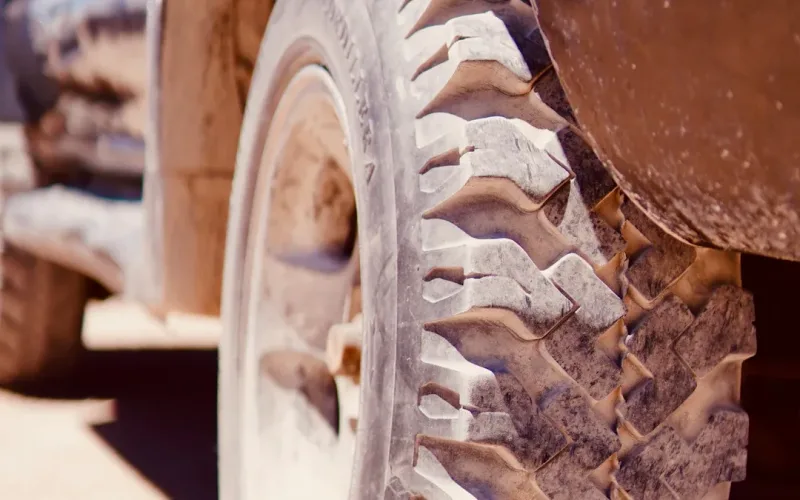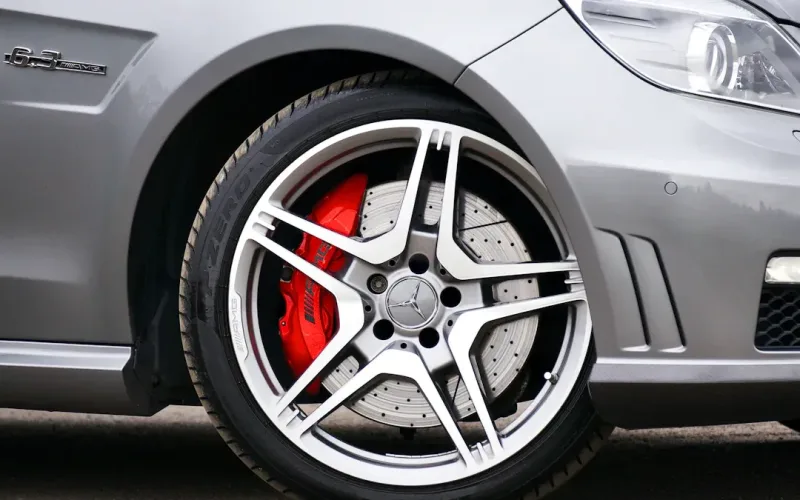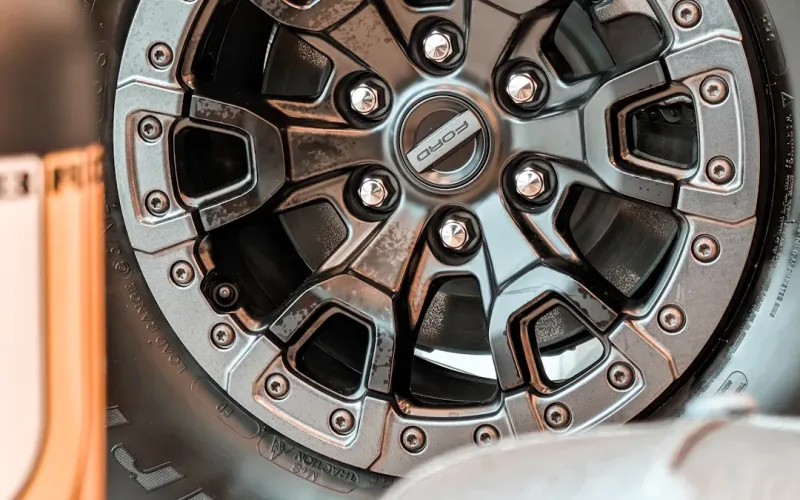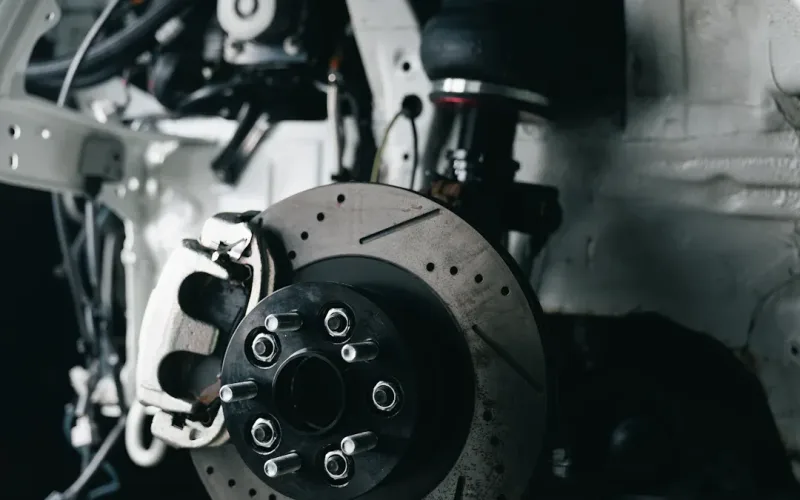

admin1
May 13, 2025
The Role of Wheel Rim Weight in Vehicle Efficiency

Wheel rim weight influences how your vehicle performs on the road. Lighter rims make your car easier to control and improve its efficiency. This happens because lightweight wheels reduce unsprung weight and rotational inertia. When your vehicle has less unsprung weight, the suspension system absorbs road bumps better. Research shows that flexible road wheels (FRWs) enhance ride comfort by lowering vertical acceleration and dynamic loads compared to rigid road wheels (RRWs). FRWs also deform evenly, offering better cushioning and stability, especially on smoother roads.
Key Concepts of Wheel Rim Weight
Unsprung Weight and Its Impact
Unsprung weight refers to the parts of a vehicle that are not supported by the suspension system, such as wheels, tires, and brakes. This weight directly affects how your car handles road surfaces. When unsprung weight increases, it reduces the vehicle’s ability to maintain consistent contact with the road. This can lead to unpredictable handling, especially on rough terrain. High unsprung weight also increases the inertia of these components, making it harder for the suspension to absorb shocks effectively. As a result, you may experience reduced traction and stability during your drive.
Did you know? Adding just one pound of unsprung weight has the same effect as adding two or more pounds of sprung weight. This highlights how critical it is to minimize unsprung weight for better performance.
Rotational Inertia Explained
Rotational inertia refers to the resistance of an object to changes in its rotational motion. For wheel rims, this means heavier rims require more energy to start or stop spinning. Research conducted at Politecnico di Milano shows that vehicles with lower rotational inertia, such as electric cars, benefit from improved control and efficiency. Advanced methods like real-time estimation using the Kalman-Bucy filter have further demonstrated how reducing rotational inertia enhances vehicle performance while lowering costs.
| Methodology | Findings |
|---|---|
| Measurement of vehicle inertia | Electric vehicles have lower moments of inertia, improving control. |
| Real-time estimation using Kalman-Bucy filter | Enhances control efficiency and reduces sensor costs. |
| Equivalent rotational inertia studies | Validated methods for simulating effects on traction motors. |
Why Wheel Rim Weight Matters
Wheel rim weight plays a crucial role in overall vehicle dynamics. Lighter rims improve acceleration, braking, and handling. They also reduce the strain on your engine and suspension system. For example, lighter wheels require less power to move, making your car more responsive. On the other hand, heavier wheels increase the moment of inertia, which means your vehicle takes longer to stop. Additionally, heavy wheels experience greater forces when hitting bumps, which can negatively impact handling and ride comfort.
| Evidence Description | Impact on Vehicle Dynamics |
|---|---|
| Adding a pound of unsprung weight is equivalent to adding two or more pounds of sprung weight. | Highlights the significant impact of unsprung weight on performance. |
| Lighter wheels require less power to move, resulting in more responsive acceleration. | Demonstrates how wheel weight directly affects acceleration and engine strain. |
| More weight increases the moment of inertia, requiring more time to stop the vehicle. | Shows the relationship between wheel weight and braking performance. |
| Heavier wheels experience greater forces when hitting bumps, affecting handling. | Indicates how wheel weight influences vehicle dynamics during driving conditions. |
| Heavy wheels impact fuel economy more in city driving than on the freeway. | Illustrates the effect of wheel weight on fuel efficiency based on driving conditions. |
By understanding these concepts, you can see why reducing wheel rim weight is essential for improving your vehicle’s efficiency and performance.
Effects of Wheel Rim Weight on Vehicle Performance

Acceleration and Deceleration
Wheel rim weight directly influences how quickly your car can accelerate and decelerate. Lighter wheels reduce unsprung weight, allowing your car to respond faster when you press the accelerator. This happens because lighter wheels exert less force on the suspension system, improving grip and responsiveness. While the measurable improvements in acceleration may seem small, they still contribute to better car performance. For example, a study revealed that switching to lighter rims resulted in only a 1.9% difference in fuel efficiency despite a 40-pound reduction in total rim weight. This highlights that rolling resistance and tire characteristics play a more significant role in acceleration than wheel weight alone.
Tip: If you want quicker acceleration and more effective braking, consider upgrading to lightweight wheels. They also reduce brake wear over time.
Braking Efficiency
The effect of wheel weight on performance becomes even more evident during braking. Heavy wheels increase the moment of inertia, requiring more force to stop the vehicle. This can lead to longer stopping distances and greater strain on your braking system. Lighter wheels, on the other hand, improve effective braking by reducing the energy needed to slow down. They also help distribute braking forces more evenly, enhancing stability during sudden stops. For instance, lighter wheels allow your car to maintain better grip on the road, especially in wet or slippery conditions. This not only improves safety but also reduces wear and tear on your brake components.
Handling and Stability
Handling and stability are critical aspects of car performance, especially during cornering. Wheel rim weight plays a significant role in how your car responds to steering inputs and maintains control on the road. Lighter wheels improve handling by reducing rotational inertia, making it easier for your car to change direction. They also enhance cornering speed and grip, allowing you to navigate turns more confidently. Studies comparing aluminum alloy wheels to steel wheels show that lighter materials improve vehicle stability. Multi-spoke designs further enhance stability by distributing weight more evenly. Additionally, alloy wheels exhibit better structural performance under applied loads, which translates to smoother cornering and better overall handling.
| Vehicle Scenario | Stability Impact | Observations |
|---|---|---|
| Control Vehicle | Baseline | Used for comparison against other scenarios |
| Three-Trailer Combination | Increased off-tracking by 8 to 9 inches | Still within highway lane width |
| Payload Addition | Stopping distance increased by <10% | Additional brakes compensated for weight increase |
By reducing wheel rim weight, you can achieve sharper handling, improved grip, and enhanced cornering speed. These benefits make your driving experience safer and more enjoyable, whether you’re navigating city streets or winding mountain roads.
Ride Comfort and Suspension Dynamics
The weight of your wheels significantly affects ride comfort and how your suspension system performs. Heavier wheels increase the load on your suspension, making it less responsive to road irregularities. This can lead to a stiffer ride and more vibrations inside the cabin. On the other hand, lighter wheels reduce unsprung mass, allowing the suspension to absorb bumps more effectively. This results in a smoother and more comfortable driving experience.
Here are some key ways wheel rim weight impacts ride comfort and suspension dynamics:
- Increased Inertia and Suspension Load: Heavier wheels create greater rotational inertia. This makes the suspension system work harder, reducing its ability to respond quickly to changes in road conditions.
- Effect on Ride Comfort and Component Wear: When unsprung mass increases, more road imperfections get transmitted to the vehicle. This not only reduces comfort but also accelerates wear on suspension components.
- Altered Handling Characteristics: Heavier wheels make steering feel heavier and less precise. This can lead to handling issues, especially during sharp turns or sudden maneuvers.
Note: Reducing wheel rim weight can improve suspension responsiveness, making your car feel more agile and comfortable on the road.
To better understand the relationship between wheel rim weight and suspension performance, consider the following metrics:
| Metric | Impact on Ride Comfort |
|---|---|
| Unsprung Mass | Heavier wheels increase unsprung mass, compromising ride quality and stability. |
| Suspension Responsiveness | Lighter wheels improve suspension’s ability to absorb bumps, enhancing ride comfort. |
| Grip and Handling | Minimizing unsprung mass leads to better grip and improved handling characteristics. |
By choosing lighter wheels, you can enhance your vehicle’s suspension dynamics, ensuring a more enjoyable and stable ride.
Fuel Economy and Energy Efficiency
Wheel rim weight also plays a crucial role in your vehicle’s fuel economy and energy efficiency. Heavier wheels require more energy to rotate, which increases the workload on your engine. This leads to higher fuel consumption, especially during stop-and-go city driving. Lighter wheels, however, reduce rotational inertia, allowing your car to use less energy to accelerate and maintain speed.
The impact of wheel rim weight on fuel efficiency becomes more noticeable in urban environments. Frequent acceleration and deceleration amplify the effects of rotational inertia. For example, studies show that reducing total rim weight by 40 pounds can improve fuel efficiency by up to 1.9%. While this may seem small, it adds up over time, saving you money at the pump and reducing your carbon footprint.
Tip: If you want to maximize fuel efficiency, pair lightweight wheels with low-rolling-resistance tires. This combination minimizes energy loss and enhances overall performance.
Electric vehicles (EVs) benefit even more from lighter wheels. Since EVs rely on battery power, reducing wheel weight helps extend their range. This makes lightweight wheels an excellent choice for eco-conscious drivers looking to optimize energy efficiency.
Advantages of Lightweight Wheels
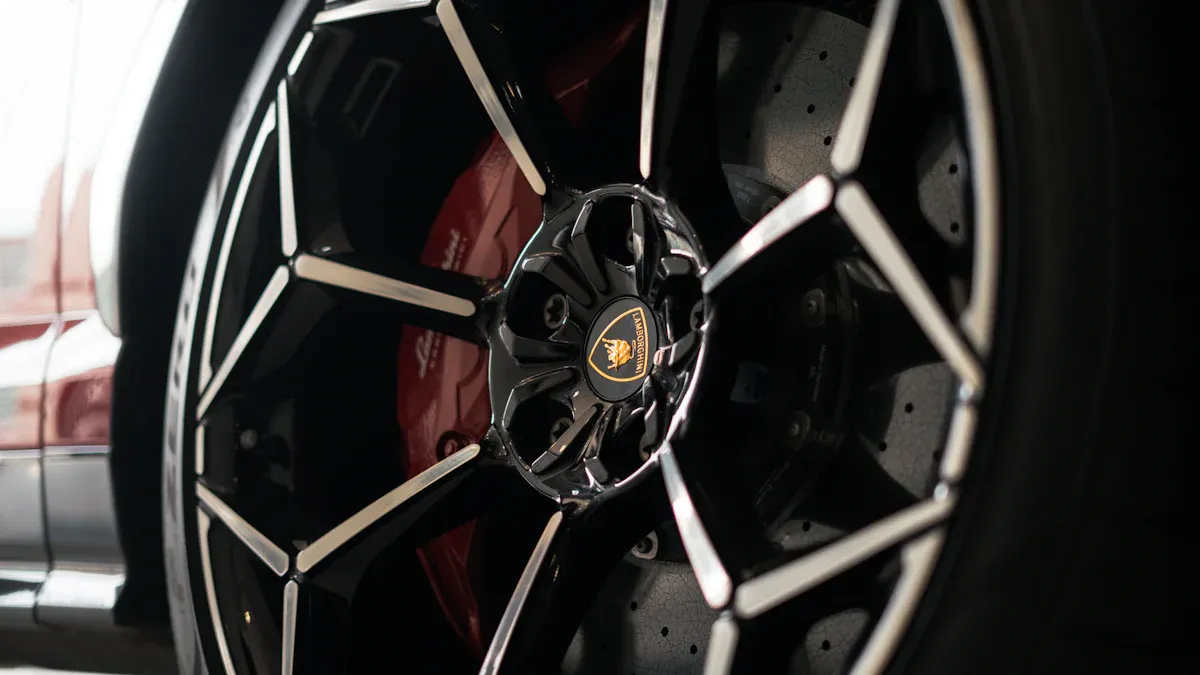
Enhanced Acceleration and Braking
Lightweight wheels significantly improve your vehicle’s ability to accelerate and brake. When your wheels weigh less, they reduce rotational inertia, allowing your car to respond faster to changes in speed. This means you can accelerate more quickly and stop more effectively. For example, research shows that reducing rim thickness from 10 mm to 7 mm can lower wheel weight by up to 24.78%. This reduction enhances braking efficiency and acceleration performance, making your vehicle more responsive during everyday driving or emergency situations.
| Material | Rim Thickness | Weight Reduction Percentage |
|---|---|---|
| Q355 | 10 mm | 5.21% |
| 540CL | 7 mm | 24.78% |
You’ll notice the difference most during stop-and-go traffic or when navigating steep inclines. Lighter wheels also reduce the strain on your braking system, helping it last longer and perform better under pressure. Every gram of weight saved on the wheelset can feel like removing several grams from static parts of the vehicle, amplifying the benefits during acceleration and deceleration.
Tip: Upgrading to lightweight wheels can improve your car’s responsiveness and reduce wear on brake components over time.
Improved Handling and Agility
Handling and agility improve dramatically when you switch to lightweight wheels. These wheels reduce the effort required to change direction, making your car feel more nimble and precise. During cornering, lighter wheels enhance grip and stability, allowing you to navigate turns with greater confidence. Multi-spoke designs and advanced materials like aluminum alloys distribute weight evenly, further improving your vehicle’s balance and control.
Aggregated performance data highlights the overall benefits of lightweight wheels compared to heavier alternatives:
| Benefit | Description |
|---|---|
| Fuel Efficiency | Spec’ing lighter weight forged aluminum wheels increases overall fuel efficiency. |
| Maintenance Savings | Lighter wheels improve maintenance savings, maximizing productivity and lowering operating costs. |
| Overall Performance | Lighter wheels reduce inertia, improve acceleration, and enhance ride quality. |
You’ll feel the difference most during high-speed maneuvers or when driving on winding roads. Lightweight wheels also reduce the load on your suspension system, ensuring smoother handling and better traction. This makes them an excellent choice for drivers who prioritize performance and safety.
Reduced Strain on Vehicle Components
Switching to lightweight wheels reduces the strain on critical vehicle components like the engine, suspension, and drivetrain. Heavier wheels require more energy to rotate, which increases the workload on your engine. Over time, this added strain can lead to faster wear and tear. Lighter wheels minimize this effect, helping your car run more efficiently and last longer.
The suspension system benefits the most from reduced unsprung weight. With lighter wheels, the suspension absorbs road bumps more effectively, improving ride comfort and reducing vibrations. This also lowers the risk of damage to suspension components, saving you money on repairs and maintenance.
Note: Lightweight wheels not only enhance performance but also extend the lifespan of your vehicle’s parts, making them a cost-effective upgrade.
By choosing lightweight wheels, you optimize your car’s efficiency, improve handling, and protect its components from unnecessary stress. Whether you’re looking for better performance or long-term savings, lightweight wheels offer a practical solution.
Better Fuel Efficiency and Lower Emissions
Reducing wheel weight directly improves your vehicle’s fuel efficiency and lowers emissions. Heavier wheels require more energy to rotate, which increases the workload on your engine. This extra effort leads to higher fuel consumption, especially during city driving where frequent stops and starts are common. By switching to lightweight wheels, you can reduce this energy demand and make your car more efficient.
When your car uses less fuel, it produces fewer emissions. This is particularly important for reducing your carbon footprint. Studies show that a 10% reduction in wheel weight can improve fuel economy by up to 2%. While this may seem small, the savings add up over time. For example, if you drive 12,000 miles per year, you could save several gallons of fuel annually just by upgrading your wheels.
Electric vehicles (EVs) benefit even more from lighter wheels. Since EVs rely on battery power, reducing wheel weight helps extend their range. Lightweight wheels decrease the energy needed to accelerate and maintain speed, allowing you to travel farther on a single charge. This makes them an excellent choice for eco-conscious drivers who want to maximize efficiency.
Here are some key benefits of lighter wheels for fuel efficiency and emissions:
- Reduced Rotational Inertia: Lighter wheels require less energy to spin, which lowers fuel consumption.
- Improved Engine Efficiency: Your engine works less to move lighter wheels, reducing wear and tear.
- Lower Carbon Emissions: Using less fuel means your car emits fewer greenhouse gases.
- Extended EV Range: Lightweight wheels help electric vehicles conserve battery power, increasing their driving range.
Tip: Pair lightweight wheels with low-rolling-resistance tires to maximize fuel savings and reduce emissions even further.
The environmental benefits of lighter wheels go beyond fuel savings. By reducing the strain on your engine and drivetrain, you also extend the lifespan of these components. This means fewer repairs and replacements, which reduces the environmental impact of manufacturing and disposing of car parts.
Choosing the right wheels can make a significant difference in your vehicle’s efficiency. Aluminum alloy wheels, for instance, are lighter than steel wheels and offer better performance. They also resist corrosion, which helps maintain their efficiency over time. Investing in lightweight wheels is not just about saving money at the pump; it’s also about contributing to a cleaner, greener planet.
Choosing the Right Wheels
Material Options: Aluminum, Steel, and Alloys
When selecting wheels, the material plays a crucial role in performance, durability, and cost. Aluminum alloy wheels are lightweight and offer excellent performance. They improve handling and fuel efficiency but come with a higher price tag. Steel wheels, on the other hand, are heavier and less expensive. They provide durability but may reduce acceleration and fuel economy. Magnesium alloy wheels strike a balance between weight and cost, offering better performance than steel but at a lower price than aluminum.
Here’s a comparison of these materials:
| Material | Rim Wheel Life (cycles) | Maximum Displacement | Cost Ranking |
|---|---|---|---|
| Aluminum Alloy | 67,687,000 | Low | Highest |
| Steel Alloy | 35,969 | Lowest | Lowest |
| Magnesium Alloy | N/A | Highest | Middle |
Aluminum alloy wheels last longer and perform better under stress, making them ideal for high-performance vehicles. Steel wheels are more suitable for rugged conditions where cost and durability matter most. Magnesium alloy wheels offer a middle ground, combining lightweight properties with moderate pricing.
Balancing Weight and Durability
Finding the right balance between weight and durability is essential. Lightweight wheels improve acceleration, braking, and fuel efficiency. However, they may not always withstand harsh road conditions as well as heavier options. Steel wheels, for instance, are highly durable but add significant weight to your vehicle. Aluminum and magnesium alloys are lighter, reducing unsprung weight and improving handling, but they may require more care to avoid damage.
You should consider your driving environment when making a choice. If you frequently drive on rough roads, steel wheels might be a better option. For smoother roads or performance-focused driving, aluminum or magnesium alloy wheels can enhance your experience. Always prioritize durability if you want your wheels to last longer without frequent replacements.
Cost vs. Performance Considerations
Cost is another critical factor when choosing wheels. While lightweight materials like aluminum and magnesium alloys improve performance, they often come at a higher price. Steel wheels are more affordable but may compromise handling and fuel efficiency. To help you decide, here’s a breakdown of cost and performance data:
| Material | Spokes | Thickness (mm) | Average Cost (USD) | Safety Factor Impact |
|---|---|---|---|---|
| Magnesium Alloy | 6 | 20 | 51.13 | Higher cost, higher safety factor |
| Stainless Steel | 5 | 17.5 | 26.6 | Lower cost, lower safety factor |
Magnesium alloy wheels, while more expensive, provide better safety and performance. Steel wheels are budget-friendly but may not deliver the same level of responsiveness or efficiency. You should weigh the benefits of improved handling and fuel savings against the upfront cost of lightweight wheels. For many drivers, the long-term advantages of better performance and reduced fuel consumption outweigh the initial investment.
Tip: Consider your driving habits and budget when choosing wheels. Investing in higher-quality materials can save you money in the long run by reducing maintenance and fuel costs.
Wheel rim weight plays a vital role in how your vehicle performs. It affects acceleration, braking, handling, ride comfort, and fuel efficiency. Reducing wheel rim weight offers several advantages that enhance both performance and sustainability.
- A 10% reduction in wheel rim weight can improve fuel economy by 6–8%.
- The automotive industry is shifting toward lightweight materials like aluminum to meet stricter emission regulations and improve miles per gallon.
The benefits of lightweight wheels extend beyond fuel savings. Vehicles with lighter rims accelerate faster, handle better, and stop more effectively. For example, a 10% weight reduction can also decrease emissions by 5–6% and increase vehicle lifespan by up to 30%.
Tip: Upgrading to lightweight wheels not only improves your driving experience but also supports a greener future.
By choosing innovative wheel designs, you can enjoy better performance, lower fuel costs, and reduced environmental impact. The growing demand for lightweight materials reflects their importance in shaping the future of automotive efficiency.
FAQ
What is the ideal weight for a wheel rim?
The ideal weight depends on your vehicle type and driving needs. For most passenger cars, lightweight aluminum alloy rims (weighing 15–20 pounds) balance performance and durability. Heavier steel rims suit rugged conditions but may reduce efficiency.
How does wheel rim weight affect electric vehicles (EVs)?
Lighter rims improve EV range by reducing energy consumption. They lower rotational inertia, allowing the motor to use less power during acceleration. This makes lightweight wheels an excellent choice for maximizing battery efficiency.
Can lightweight wheels handle rough roads?
Yes, lightweight wheels made from high-quality materials like forged aluminum or magnesium alloys can handle rough roads. These materials combine strength and durability while minimizing weight, ensuring performance without compromising safety.
Do lightweight wheels require special maintenance?
Lightweight wheels don’t need special maintenance but may require extra care to avoid damage. Regular cleaning and inspection help maintain their performance. Avoid hitting curbs or potholes to prevent cracks or bends.
Are lightweight wheels worth the investment?
Yes, lightweight wheels enhance acceleration, braking, handling, and fuel efficiency. While the upfront cost may be higher, the long-term savings on fuel and reduced wear on vehicle components make them a cost-effective upgrade.
